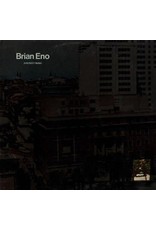Eno, Brian: Discreet Music LP
| Availability: | Out of stock |
Available both as a regular 33rpm LP or as an audiophile double 45rpm. While his earlier work with Robert Fripp on No Pussyfooting and several selections from his own Another Green World feature similar ideas, Discreet Music marked a clear step toward the ambient aesthetic Brian Eno would later codify with 1978's Ambient 1: Music for Airports. The inspiration for this 1975 album began when Eno was hospitalized after an accident. Whilst bed-ridden and listening to a record of 18th-century harp music, the volume was too low and he couldn't reach to turn it up. It was raining outside, and Eno recounts he began listening to the rain and to "these odd notes of the harp, that were just loud enough to be heard above the rain." "This presented what was for me a new way of hearing music – as part of the ambience of the environment, just as the colour of the light and the sound of the rain were parts of that ambience," he observed. The A-side of the album is a 30-minute piece titled "Discreet Music," which Pitchfork called "one of the greatest single ambient pieces that Eno has produced." It was made using two overlapped tape loops of melodic synthesizer phrases of different lengths. This technique became known as ‘Frippertronics'; one of Eno's early forays into algorithmic, generative composition – exploring multiple ways to create music with limited planning or intervention. The second half of the album, titled "Three Variations on the Canon in D Major by Johann Pachelbel" features the Cockpit Ensemble, playing brief excerpts from the score, which were repeated several times, with the tempo and other elements gradually altered – the end result of which "forced the listener to switch fundamental modes of hearing," Pitchfork proclaimed. thereby improving the signal to the noise ratio.





